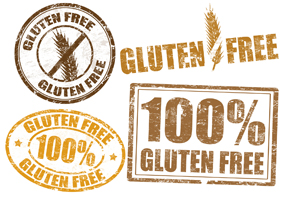Gluten-Free Foods and Gluten-Free Labeling
The gluten-free product market is one of the fastest-growing consumer segments. In a recent survey, 80% of food buyers said they prefer products labeled “gluten-free.”
So what is gluten?
The word comes from a Latin term meaning “glue.” This is fitting, because gluten is a glue-like or sticky protein substance.
Gluten gives elasticity to dough and chewiness to the end products in foods derived from wheat, barley, rye, and oats. But for many people, eating gluten is a terrible idea.
Gluten Sensitivity and Celiac Disorder
Individuals whose intestines have trouble breaking down gluten are said to have “gluten sensitivity.” Clinical nutritionist Dr. Vikki Petersen believes most people have a version of this condition, and that if you’re eating gluten, it may be triggering a “deleterious effect on your health” that you’re not aware of.
Those with more severe problems processing gluten may have celiac disease, a disorder that causes serious digestive complaints and that may develop at any age.
Researchers disagree about the prevalence of gluten sensitivity and celiac disorder. Estimates range from 1 in 170 people globally for celiac disease to as many as 1 in 3 among Americans for gluten sensitivity.
What Is a Gluten-Free Diet?
A solution for gluten sensitivity and celiac disorder is a gluten-free diet.
One version of this diet is what our cave-dwelling ancestors ate. Dominated by seafood and lean meat, it also includes fruits, vegetables, nuts, and seeds.
Another type of gluten-free diet adds eggs, dairy products, and legumes.
Still another allows potatoes, rice, and maize as substitutes for wheat, barley, rye, and oats, and it permits gluten-free “pseudo cereals”: quinoa, amaranth, and buckwheat.
How Is the Label “Gluten-Free” Regulated?
The problem of pursuing a gluten-free diet is that it’s not always easy to determine which foods do or don’t contain gluten.
Gluten is present in more than just baked goods; it’s found in items as diverse as milkshakes, salad dressings, and beer. That’s why standardized gluten-free labeling is important.
Partly due to Gluten-Free Certification Organization (GFCO) lobbying, in 2014 the U.S. Food and Drug Administration (FDA) established rules for the use of the term “gluten-free” in labeling food.
FDA “gluten-free” label laws apply to all FDA-regulated foods, as well as to dietary supplements such as vitamins, and to imported products subject to FDA regulation.
In addition, the GFCO and similar organizations certify products and companies as gluten-free.
Gluten-free labeling and certification encourage consumer confidence and trust, and 76% of shoppers assert that they look for gluten-free labels on packages.
Green Nature Marketing
Green Nature Marketing and our sustainable brands are committed to supporting the foodservice community. We appreciate any opportunity to work with the established foodservice distribution supply chain to accommodate our customer’s needs for excellent customer service. If you are interested in learning more about our brands or have questions regarding our company, please get in touch via email at communications@greennaturemktg.com or through our website, https://greennaturemktg.com/contact/.








